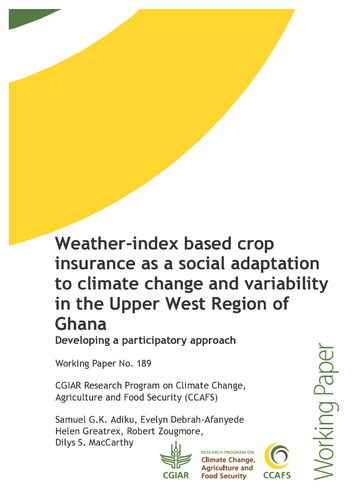Weather-index based crop insurance as a social adaptation to climate change and variability in the Upper West Region of Ghana: Developing a participatory approach
Abstract
Climate change and variability are major challenges to rain-fed crop production in Africa.
This paper presents a report on a pilot project to test a concept for operationalizing weatherindex
crop insurance as a social adaptation to the climate change and variability problem in
the Upper West Region of Ghana. An analysis of long-term weather variables showed rising
temperature of 1.7 oC over a period of 53 years as well as major shifts in rainfall patterns.
Farmers face a new reality that cannot be addressed with their indigenous knowledge alone.
The weather-index based crop insurance concept discussed herein was developed by
combined effort of University of Ghana, the German International Cooperation (GIZ) and the
Ghana National Insurance Commission (NIC) since 2010. This development was carried out
via their filial, the Ghana Agricultural Insurance Pool (GAIP). The proposed concept sought
to link various agricultural stakeholders such weather technical persons, farmers, agricultural
extension officer, input dealers and other aggregators, and financial institutions as well as the
insurance industry and focused on a participatory farmer led approach. The piloting of the
concept was supported by the Climate Change and Food Security (CCAFs) project and was
tested in the years 2012 and 2013 using a theatrical drama sketch in two districts in the Upper
West Region of Ghana: Jirapa and Lawra. It was observed that training of farmers in the basic
principles of weather (data collection, interpretation, etc.) facilitated the discussions on
drought insurance, adding to the body of evidence supporting participatory design tools.
The aim of this paper is to record this process and to put the results into recent context,
through discussing them through the lens of insurance operations and research in Ghana.
Ensuing discussions showed that although all stakeholders considered the participatory design
tools to be meritorious, a number of logistical challenges were identified that need to be
addressed for effective scaling. The study also highlighted the high spatial variability of
rainfall in the Upper West region of Ghana, showing the necessity of satellite-derived rainfall
products. Finally, the framework suggested in this report highlights the complexity and the
institutional structures required to implement an effective insurance. In effect, our simple
study has exposed the complexities and intricacies that must be overcome in establishing a
sustainable insurance scheme in Ghana.

